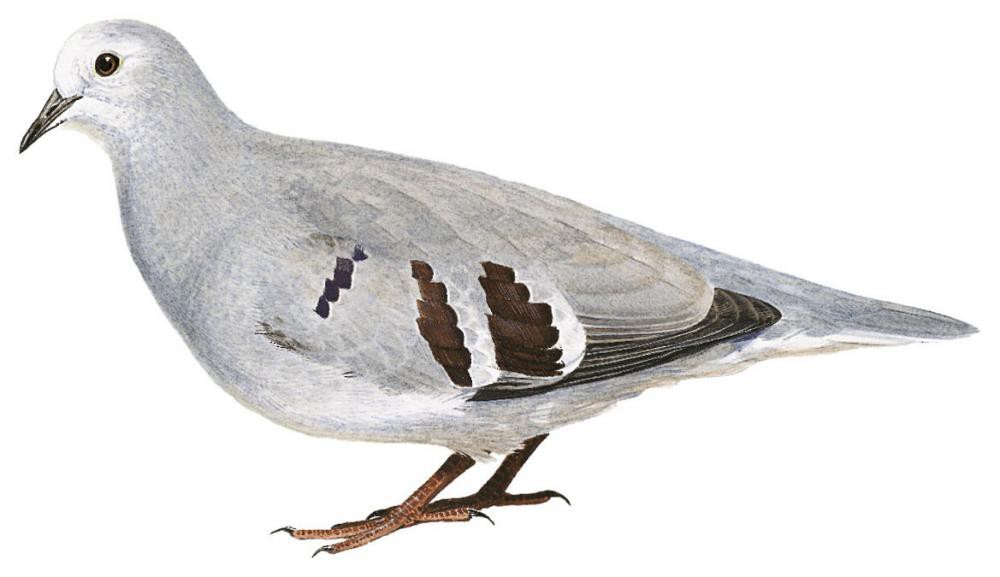Purple-winged Ground Dove / Paraclaravis geoffroyi

Purple-winged Ground Dove
SCI Name:
Protonym: Columba Godefrida LesPigeons[Knip] p.125 pl.57
Taxonomy: Columbiformes / Columbidae / Paraclaravis
Taxonomy Code: pwgdov1
Type Locality: Brazil.
Author: Temminck
Publish Year: 1811
IUCN Status: Critically Endangered
DEFINITIONS
PARACLARAVIS
(Columbidae; Ϯ Maroon-chested Ground Dove P. mondetoura) Gr. παρα para near; genus Claravis Oberholser, 1899, ground dove; "The first name applied to the three species currently placed in Claravis was Peristera Swainson, 1827, which has Columba cinerea Temminck, 1811 [now Claravis pretiosa (Ferrari-Pérez, 1886)] as its type species. As pointed out by Oberholser (1899), the name Peristera Swainson, 1827 is preoccupied by Peristera Rafinesque, 1815 (Gastropoda). Oberholser (1899) proposed Claravis as a replacement name and this has been in use ever since. No other genus-group names have been proposed for any of these species. The phylogenetic evidence reviewed above indicates that the generic name Claravis should be restricted to C. pretiosa; Claravis thus becomes a monotypic genus. As no name is available for C. mondetoura and C. geoffroyi, we propose a new genus for them. Paraclaravis, new genus. Type species. Peristera mondetoura Bonaparte, 1856, currently Claravis mondetoura. ... Diagnosis Small (18-24 cm), arboreal or semi-terrestrial doves, similar to Claravis pretiosa, but both sexes of Paraclaravis differing from C. pretiosa in having: (i) lesser upperwing-coverts marked with a single bar formed by spots on a single row of feathers; and (ii) tertials unmarked. ... Males of the two species of Paraclaravis differ from male C. pretiosa in two additional characters: (iii) extensive white on distal parts of outer rectrices (entirely black in C. pretiosa); and (iv) white under tail-coverts (slate-grey in C. pretiosa) ... The two species of Paraclaravis differ from all other small ground-doves, except Claravis pretiosa, by a combination of pronounced sexual dimorphism in colouration, upperparts grey in males, tail truncated, bare orbital space small, lores wholly feathered, and wing feathers spotted with extensive markings forming three prominent dark wing bars (Ridgway 1916). Etymology. The generic name is derived from the Greek para (beside), the Latin clarus (clear, brilliant) and the Latin avis (bird). Its gender is feminine. The name refers to the morphological resemblance of Paraclaravis mondetoura and P. geoffroyi to Claravis pretiosa." (Sangster et al. 2018).
geoffroy / geoffroyanus / geoffroyi / geoffroyii
● Prof. Étienne Geoffroy-Saint-Hilaire (1772-1844) French zoologist (syn. Charadrius leschenaultii, syn. Cissilopha beecheii, Geoffroyus (ex “Perroquet Geoffroy” of Levaillant 1805), Neomorphus, Paraclaravis).
● Prof. Isidore Geoffroy-Saint-Hilaire (1805-1861) French zoologist (syn. Garritornis isidorei, syn. Glareola ocularis, syn. Philepitta castanea, Schistes).
● Albert Geoffroy-Saint-Hilaire (1835-1919) French zoologist, Director of Jardin d’Acclimatation du Bois de Boulogne 1865-1893 (subsp. Ithaginis cruentus).
UPPERCASE: current genus
Uppercase first letter: generic synonym
● and ● See: generic homonyms
lowercase: species and subspecies
●: early names, variants, mispellings
‡: extinct
†: type species
Gr.: ancient Greek
L.: Latin
<: derived from
syn: synonym of
/: separates historical and modern geographic names
ex: based on
TL: type locality
OD: original diagnosis (genus) or original description (species)












